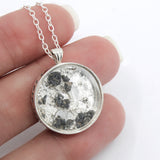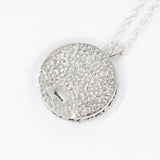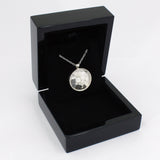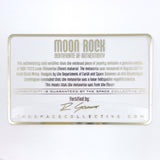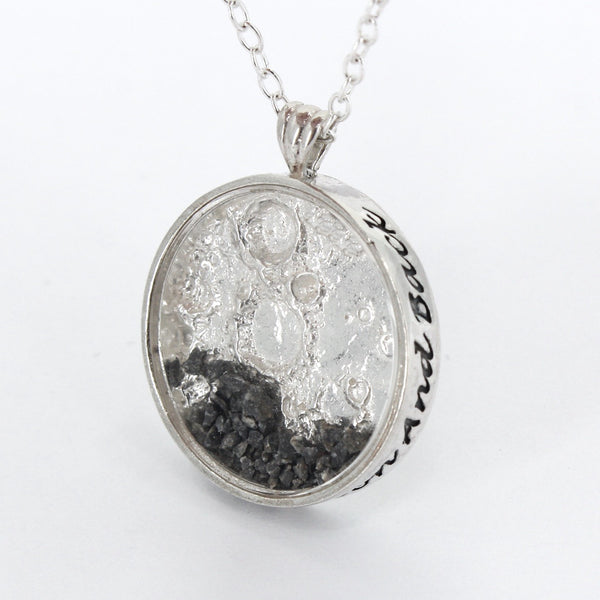A necklace that will leave her speechless!
This exquisitely detailed meteorite pendant is carved in 3D and is an exact replica of the Aristarchus Plateau; home to the brightest of the Moon's largest craters that also happens to be deeper than the Grand Canyon!
"I Love You To The Moon And Back" is engraved around the pendant, encircling the genuine pieces of the Moon contained within!
The pendant is made from solid sterling silver and measures approximately ⅞" in diameter and just over ⅛" deep, and the moon meteorites (which may vary in color from the photos) are encased under a scratch-resistant crystal face.
• Solid sterling silver pendant and chain
• Engraved with "I Love You To The Moon And Back"
• Contains 60-100mg of genuine moon meteorites/dust (from NWA 11273)
• Meteorite pendant measures 2.6cm x 2.2cm (approx. ⅞" x ⅛")
• Stamped with the maker's mark and sterling silver stamp
• Includes a 20-inch .925 sterling silver chain
(18" + 2" extender)
• Comes in an elegant black wooden gift box
• Includes a certificate card of authenticity
• Nickel-free
• Handmade in The United Kingdom
About the Aristarchus Plateau:
The Aristarchus Plateau fascinated lunar observers long before the space age began due to its unusual shape and low and high reflectance extremes. The plateau features a spectacular channel, or rille, and the very young Aristarchus Crater. Aristarchus is the brightest of the large lunar formations, with an albedo close to double most of the moon's features. The crater is so bright that it is visible to the naked eye and displays unusually bright features when viewed through a telescope. The lava flows of Oceanus Procellarum surround the plateau, with the region hosting a high concentration of sinuous rilles. The largest of them is Vallis Schroeteri, which is also the largest sinuous rille on the moon. The plateau is nearly completely covered by one of the largest lunar regional pyroclastic deposits on the moon, and due to its geological complexity and resource potential, the Aristarchus region is poised to be a potential future landing area for lunar missions. This area is also noted for a significant number of reported transient lunar phenomena, as well as recent emissions of radon gas as measured by the Lunar Prospector spacecraft. Authentication Information The moon rocks contained within this pendant were collected from a larger lunar meteorite.
How did the meteorites in this necklace come to Earth?
Our moon is covered in craters, caused by space debris crashing into the surface of the Moon during the course of its long life. When a sizable object impacts the Moon the force of the impact flings debris into space, some of which eventually finds its way to Earth after getting caught in Earth's gravitational pull and tumbling through our atmosphere, landing on the surface of our Earth. When a lunar rock lands on Earth like this, it becomes known as a meteorite! Hunters and collectors search out meteorites, and if they are especially lucky they find a lunar meteorite. Lunar meteorites comprise less than 1% of all meteorites found on Earth!
Authenticity Information:
The moon rocks within were collected while cutting a lunar meteorite. It was sourced from one of the world's most respected collectors of planetary meteorites in the world. The meteorite has been analyzed and authenticated by a top laboratory and given the official meteorite registration number NWA 11273, and a complete analysis and composition breakdown of this meteorite is publicly available on the International Society for Meteoritics and Planetary Science website.
Have a Question?
Be the first to ask a question about this.












